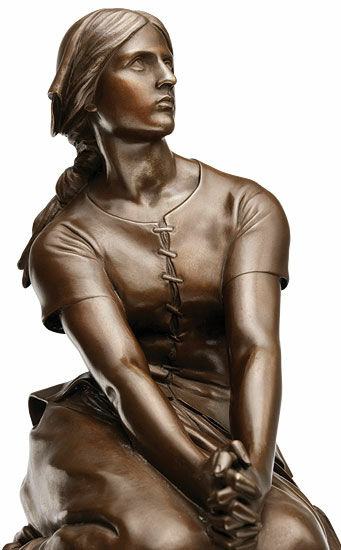Sculpture "Joan of Arc" (c. 1880), bronze version
Sculpture "Joan of Arc" (c. 1880), bronze version
Quick info
ars mundi Exclusive Edition | limited, 199 copies | numbered | signed | edition in bronze | patinated | polished | Ø 20.5 cm | height 28.5 cm | weight approx. 4.55 kg
Detailed description
Sculpture "Joan of Arc" (c. 1880), bronze version
She sits with hands folded, calm - tenderly and confidently gazing into the distance. Joan of Arc (1412-1431) was accused by the Inquisition and executed in adverse circumstances, but she became a French myth. In 1920, she was canonised by the Catholic Church.
Original: Marble, Musée d'Orsay, Paris.
Bronze sculpture. Cast using the Lost-Wax-Process, finely patinated and polished by hand. Limited edition of 199 copies, numbered and signed. Size 20.5 x 28.5 x 20.5 cm (w/h/d). Weight approx. 4.55 kg. Exclusively at ars mundi.
About Henri Michel Chapu
1833-1891
The French sculptor and metal artist made his debut at the age of 22 at a major exhibition at the Paris Salon in 1855. Chapu was so convincing there that one of his works was awarded the "Prix de Rome" by the Rome Academy of Art. This also included a scholarship of several years in the Italian capital.
He was inspired by themes from ancient mythology and combined them with the typical naturalistic style of that time. In this way, his figures experience an idealistic elevation, as does the famous "Statue of the Cantata", which adorns the main entrance of the Opéra de Paris. Chapu's sensitive works were popular. He received many commissions for public spaces. Among others, the statue of the jurist Pierre-Antoine Berryer for the Paris Palace of Justice was his creation.
An alloy of copper with other metals (especially with tin) used since ancient times.
When casting bronze, the artist usually applies the lost-wax technique which is dating back more than 5000 years. It's the best, but also the most complex method of producing sculptures.
First, the artist forms a model of his sculpture. It is embedded in a liquid silicone rubber mass. Once the material has solidified, the model is cut out. The liquid wax is poured into the negative mould. After cooling down, the wax cast is removed from the mould, provided with sprues and dipped into ceramic mass. The ceramic mass is hardened in a kiln, whereby the wax flows out (lost mould).
Now we finally have the negative form, into which the 1400° C hot molten bronze is poured. After the bronze had cooled down, the ceramic shell is broken off and the sculpture is revealed.
Now the sprues are removed, the surfaces are polished, patinated and numbered by the artist himself or, to his specifications, by a specialist. Thus, each casting becomes an original work.
For lower-quality bronze castings, the sand casting method is often used which, however, does not achieve the results of a more complex lost-wax technique in terms of surface characteristics and quality.
Graphic or sculpture edition that was initiated by ars mundi and is available only at ars mundi or at distribution partners licensed by ars mundi.
Term for an art object (sculpture, installation), which is produced in multiple copies in a limited and numbered edition according to the artist‘s will.
Artist's multiples have been called the most accessible and affordable art on the market.
A plastic work of sculptural art made of wood, stone, ivory, bronze or other metals.
While sculptures from wood, ivory or stone are made directly from the block of material, in bronze casting a working model is prepared at first. Usually, it is made of clay or other easily mouldable materials.
The prime time of sculpture after the Greek and Roman antiquity was the Renaissance. Impressionism gave a new impulse to the sculptural arts. Contemporary artists such as Jorg Immendorf, Andora, and Markus Lupertz also enriched sculptures with outstanding works.









